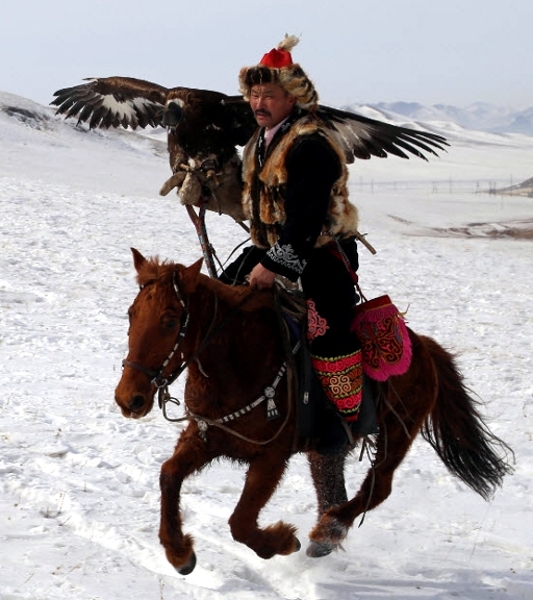|
 |
A Ride for Peace Crosses Two Continents -
Equestrian travellers set off on journeys for a variety of reasons,
including wanderlust, to promote a worthy cause or just to enjoy exploring
the world on horseback. Italian Long Rider Paola Giacomini was
different. She made a record-making ride to heal an ancient wound that had
festered for 777 years between Mongolia and Poland.
READ MORE… |
| |
|
 |
The publication of two remarkable stories marks a special moment in modern
equestrian travel history. In 1973 Sean Jones, Kevin Rigby
and Raffaele Favero rode across Afghanistan. That remarkable
adventure is recounted in Sean’s article
The Company of Horses. |
 |
The three Long Riders set off to ride from Afghanistan, over the Khyber
Hills into Pakistan’s Tribal areas. Their plans went astray when they were
Captured by Afghan Bandits.
|
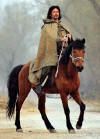 |
In August 2007 Jing Li began an epic
journey on horseback. He had a small amount of money, a sleeping bag, a sweater,
a tent, and a photo of his son, Maksim. Starting at Votkinsk, Russia, his
route took him through the Ural Mountains, which serves as the Continental
Divide between Europe and Asia. Finally, after eighteen months in the
saddle, and having ridden 9,000 kilometres (5,592 miles), Jing Li reached the
capital of China. |
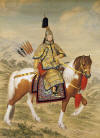 |
Journey to the Western Regions
This is the oldest known example of a Story from the Road. In 1414 a Chinese
diplomat named Chen Cheng was ordered by Emperor Yongle to undertake a
hazardous equestrian journey to the distant city of Herat. Located in
today’s modern Afghanistan, Herat was then the capital of the Timurid
empire. Chen Cheng’s mission was to deliver precious Chinese silks to
Emperor Shahrukh. In exchange, the Chinese Long Rider was ordered to obtain
a large herd of the valuable horses used by Shahrukh’s legendary mounted
archers. Though a handful of scholars were aware of Chen Cheng’s journey,
Dr. Sally Church completed the first translation of the Long Rider’s diary.
The result is a day to day account which has the ring of authenticity about
it. Chen Cheng runs into many problems, all of which he records. While
these include snow storms and bad trails, one of the most telling is the
brief account of how the horses drown trying to cross the river. (PDF)
|
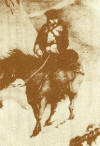 |
Samurai Warrior – Broken Heart
The most noted Japanese Long Rider was Baron Yasumasa Fukushima. This
descendant of a noble Samurai family was sent to Berlin, Germany on military
duty in 1892. When the time came to return home, the Japanese horseman
elected to ride
his horse
Gaisen, (Triumphant Return) 14,000 kilometres from Berlin to Tokyo.
A fellow soldier, General Rafael de Nogales, described the equestrian
explorer thus, "Fukushima’s courage, drive and exuberant cheerfulness were
amazing. For a man like this nothing was impossible." Yet even Samurai
warriors must suffer emotional hardships on the long grey road, as is
evidenced by the heart-breaking account the Baron wrote regarding the loss
of his beloved horse, Gaisen.
|
 |
Riding Across Korea
Though Korea is now separated into two
hostile nations, in 1894 it was a kingdom where ancient customs still held
sway. Having already ridden in Hawaii, Persia, Japan and Tibet, Isabella
Bird was determined to put her saddle on one of Korea’s notoriously savage
horses and set off in search of more adventures.
The first
woman to be made a Fellow of the Royal Geographical Society, and one of the
most celebrated travel writers of the 19th century, Bird’s account of Riding Across Korea provides a glimpse
into a lost age.
|
 |
My Rascal of a Pony
Ask any Long Rider and they will tell you that equestrian journeys have a
way of hardening your soul against adversity. You learn to dig down and push
on when your road is a long one. This type of travel requires a special type
of person, one who wishes to know the world intimately and to judge other
people by first-hand experience. Though English Long Rider George
Younghusband maintained a modest demeanour in this story, taken from his
book "Eighteen
Hundred Miles on a Burmese Pony",
he was anything but the "ordinary British Subaltern" as he described
himself. The small equestrian travel book he wrote at the conclusion of this
trip did not profess to be any sort of literary classic. It was, like
George, a modest, faithful, and cheerful account of new countries
encountered with the iron-grey pony he rode to Siam in 1897.
|
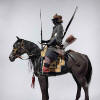 |
Long Riders on the Roof of the World
In spite of its peaceful reputation Tibet has the dubious honour of being
the only country the Guild is aware of where Long Riders were repeatedly
murdered. A special study, investigating Tibetan equestrian travel history
in the 19th and 20th centuries, demonstrates some of the most astonishing
and dangerous horse journeys ever undertaken came to tragic conclusions in
what was once known as “the hermit kingdom.” |
 |
A Caravan Journey Across Tibet
In 1940, Thubten Jigme Norbu, oldest brother of the Dalai Lama and himself a
reincarnated lama, wanted to travel to Lhasa to visit his brother. He asked
his father's permission several times, meanwhile making the wildest plans to
travel to Tibet on his own. Eventually his father sent permission, and
Norbu's retinue plunged into preparations for the long journey to
Lhasa. This story recounts the four-month caravan trip, most of it through
empty and debatable lands, undertaken by the Tibetan Long Rider.
|
 |
Across Tibet from India to China
In the Spring of 1942, when the war looked grimmer day by day to the Allies,
and the Burma Road was lost, Count Ilia Tolstoy was given the assignment of
crossing Tibet from India to China. Armed with a letter and precious gifts
from President Franklin D. Roosevelt to the Dalai Lama, Tolstoy and his
companion, Captain Brooke Dolan, crossed Tibet. Although they were treated
like royalty, there was always the threat of bandits lurking in the
dangerous terrain.
|
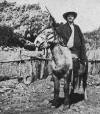 |
To Save a Country
The Khamba warlord in Tibet had given George Patterson a deadly mission -
carry word to the outside world that the Chinese Communists were about to
secretly invade the mountain kingdom. The problem was that the winter of
1949 had turned the mighty Himalayas into a wall of ice and the only trail
leading to India had never been travelled by horsemen! Could the Scottish
Long Rider and his horse survive the snow covered journey and bring back
help to his adopted homeland?
|
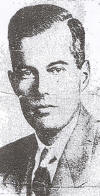 |
Death in Tibet
In 1950, CIA agent Douglas MacKiernan (left) and his young friend, former
student turned espionage agent, Frank Bessec, found themselves being hunted
across the Takla Makan desert by armed Chinese communists. Their daring
horseback escape across Western China and into Tibet, which they thought had
led them to safety, ended in tragedy. After fifty years, the Top Secret
diary which Bessec kept during this amazing equestrian journey has been
declassified by the American State Department and is offered to the public
for the first time by The Long Riders' Guild.
|
 |
Escape Across Tibet
In 2002, after the death of his spiritual advisor, New Zealand Long Rider
Ian Robinson vowed to deliver his mentor’s ashes to Mount Kailas, Tibet's
most sacred mountain. Fighting cold, exhaustion and runaway horses, he
camped in high mountains with wolves, dicing with the elements and altitude
sickness. Then things really got bad. Ian was pursued across Tibet for three
weeks by Chinese police intent on capturing and expelling the Long Rider.
|
 |
An Explorer in Asia
Tim Cope -National
Geographic Adventure Honoree 2007, Australian Adventurer of the year 2006
- is a Long Rider from Gippsland, Victoria (Australia), who is pursuing a
life of adventure, writing, and film. Tim, who speaks fluent Russian, and
guides in Siberia, and Mongolia, has spent the best part of a decade
travelling Russia, Mongolia, and Central Asia by bicycle, row boat, skis,
horse, camel and many other means. Most of all Tim enjoys coming to know
people in their home environments by travelling in traditional and local
ways. His most renowned journey was a three and a half year odyssey from
Mongolia to Hungary by horse on the trail of Genghis Khan and in the spirit
of the nomads of the steppe. |
 |
Lasting Impressions – Mongolia from the Saddle
Kathrin Nienhaus made a series of accurate observations when she rode across
part of Mongolia in 2004. Horses, nomad life, lack of privacy, all these and
many more are recounted in her article.
|
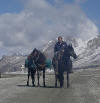 |
Long Ride in Central Asia
In 2007 French Long Rider Nicholas Ducret left on an equestrian journey. His
intention was to cross Central Asia from Kazakhstan to Afghanistan. After
months of hard travelling, he reached Kabul.
|
 |
Riding with the Eagle Hunters in Mongolia
Beginning in 2008, Canadian Long Rider Bonnie Folkins’ mission was to use
her horse and camera to arrive at a deeper understanding of Central Asia’s
remaining nomads. Though she has travelled and photographed in Italy, India,
Australia and Latin America, the impassioned Long Rider has been repeatedly
drawn back to the land of horses and free riders. In this interview, Bonnie
explains her quest to understand nomadic culture. |
|
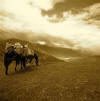 |
Imprisoned in India
Daniel Robinson decided to travel from China to India in 2007. The young man
made a journey which required equal doses of courage, stamina and naivety,
but his journey had ended with him being unfairly imprisoned. Thanks to an
international campaign which was organized by the Long Riders’ Guild, Daniel
was freed. The article entitled
“The Price of a Pilgrimage
recounts this incredible equestrian adventure. |
 |
Colic in Mongolian Horses
Taking a keen interest in the natural world is one of the treasured
traditions of equestrian explorers.
Carl Linnaeus,
who devised the system used to classify all living beings, rode across
Lapland in 1732. Before he wrote his famous book,
Charles Darwin
rode in South America, Australia and Africa. British Long Riders Tim Mullen
and Sam Southey also rode in search of answers. During their journey across
Mongolia in 2013 they undertook a survey of the incidences of colic among
Mongol Horses. The first “Mongol Colic Study” reveals surprising
discoveries.
|
